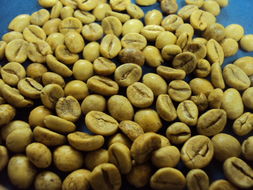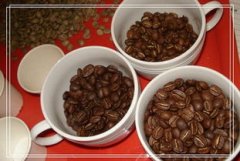Cultivation and Development of Robusta Coffee
Robusta coffee, commonly known as "robust beans", can be grown at low altitudes (200 to 800 meters above sea level), is highly resistant to pests and diseases, is not susceptible to agricultural damage, has a high annual yield per unit area of coffee trees, is harvested in large quantities by machines, and generally costs much less than Arabica coffee.

Robusta coffee is usually plain, dull, pungent, and because most of the world's Robusta coffee is grown in low-altitude areas (author's note: as of May 2008, only India has rare high-altitude, high-quality, washed Robusta coffee beans). When unroasted, it smells like raw peanuts. Cheap Robusta coffee beans usually exhibit a taste between "wheat tea flavor"(medium light roast) and "rubber tire flavor"(deep roast) after roasting, which is difficult to show detailed flavor.
Robusta isn't exactly cheap coffee!
Arabica coffee accounts for 75 percent of the world's coffee production, and quality varies widely, from good to bad. In recent years, a few countries, such as India, have made efforts to improve the quality of Robusta coffee. They have planted Robusta at high altitudes, subjected it to the most careful care, and carefully washed it, resulting in very excellent quality Robusta coffee beans! Top Robusta beans are not cheap either, get rid of the old impression that Robusta is all cheap beans! Therefore, the quality of coffee beans can no longer be judged by the crude and outdated ancient standard of "Arabica beans."
Asia is home to Robusta coffee, with six of the world's largest Robusta coffee exporters, three in Asia alone, accounting for two-thirds of global production. Vietnam, the world's leading exporter of Robusta coffee
Coffee Robusta Linden
Robusta coffee beans are generally used for instant coffee because it extracts coffee liquids that are roughly twice as high as Arabica.
The caffeine content is 3.2%, more than twice that of Arabica, which is 1.5%.
How to identify Robusta coffee beans?
Not in the book, but I think there are three things worth noting. The first was the size, shape, and body shape of the beans. The second was the middle lines and edge lines of the beans.
The third is cooked beans, eat directly, taste.
Important Notice :
前街咖啡 FrontStreet Coffee has moved to new addredd:
FrontStreet Coffee Address: 315,Donghua East Road,GuangZhou
Tel:020 38364473
- Prev

What is boutique coffee? how do you evaluate it?
Generally speaking, the level of coffee in circulation in the market is based on the export specifications of various countries.
- Next

Robusta that you don't know about coffee (part one)
People always habitually look at things in dichotomy, good and bad, good and evil, good and bad. The same is true in the world of coffee. Arabica coffee beans are always classified as good, while its distant relative, Robusta, is often classified as bad. We might describe it this way, if Arabica is an angel's gift.
Related
- Beginners will see the "Coffee pull flower" guide!
- What is the difference between ice blog purified milk and ordinary milk coffee?
- Why is the Philippines the largest producer of crops in Liberia?
- For coffee extraction, should the fine powder be retained?
- How does extracted espresso fill pressed powder? How much strength does it take to press the powder?
- How to make jasmine cold extract coffee? Is the jasmine + latte good?
- Will this little toy really make the coffee taste better? How does Lily Drip affect coffee extraction?
- Will the action of slapping the filter cup also affect coffee extraction?
- What's the difference between powder-to-water ratio and powder-to-liquid ratio?
- What is the Ethiopian local species? What does it have to do with Heirloom native species?

